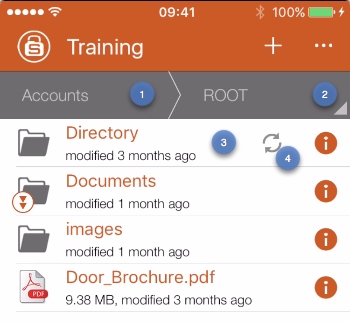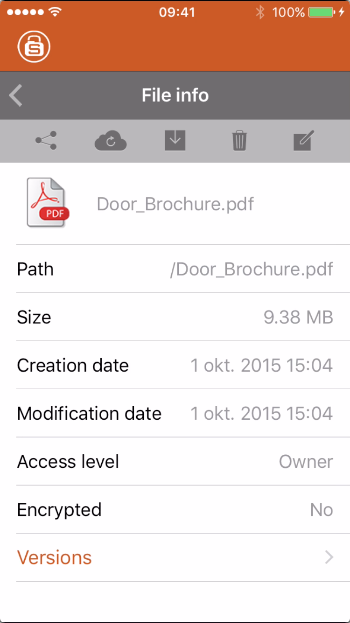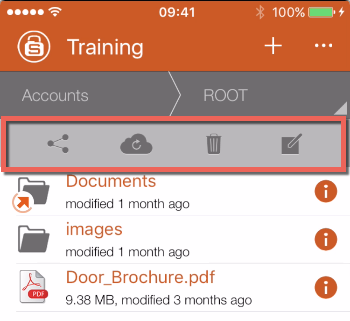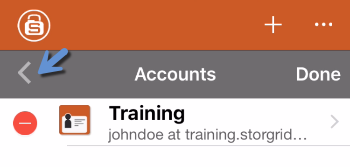Working with the client¶
Accounts¶
On the Storgrid client you can install more than one account. For example if you need to connect to two separate Storgrid servers. You can reach the account overview by pressing the “Account” button. From the main file navigation menu.
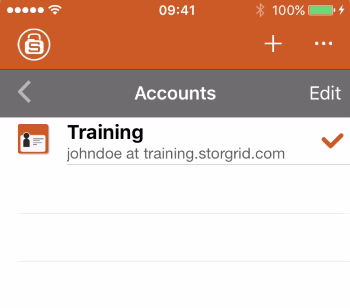
Every account has a certain status which can be seen in above picture depicted by the  icon.
icon.
Details status icons:
Icon |
Description |
|---|---|
Client is up to date |
|
Client is synchronising |
|
Server is not responding |
|
An error has occurred |
|
Client is disconnected |
From the Account overview its possible to add, edit and delete accounts.
Add account¶
Edit Account¶
Delete Account¶
You can delete an account in two ways.
Warning
If you delete an account you won’t be able to recover any non synced local files on your device.
First method:
Go to account overview
Slide relevant account to the left
Touch the delete button
Confirm deletion with tapping “Delete Account”
Second method:
File/Folder Operations¶
Copy/Move/Delete¶
You can copy, move or delete one or multiple folders using “Select” from ![]() .
.
Copy/Move¶
The difference between Copy and Move is that when you copy a file (or directory), first a copy is made of source files, in the latter case the files will be moved.
Follow these steps to Copy or Move:
Delete¶
Select files or directories
Select “Delete” to confirm deletion
Hint
When you delete or change a file a copy of the previous file will be stored in Storgrid. So you can always restore the file. See Versioning for details.
Rename¶
You can only rename a file or folder one at a time. This can be achieved in two ways. Either by pressing the ![]() button or swiping the file or folder to the left from the file navigator and by pressing the
button or swiping the file or folder to the left from the file navigator and by pressing the ![]() icon.
icon.
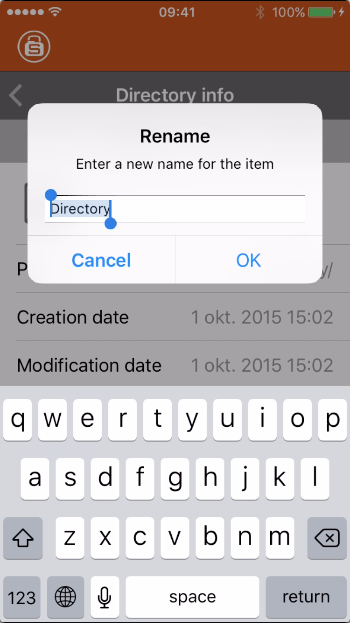
Client Side Encryption¶
Note
This feature is only available when purchased, it’s not available by default.
One of the most important features is CSE (Client Side Encryption). When CSE is enabled on a file or folder it will encrypt those files when they’re synced to your iOS device locally. This way you can work safely with e.g. an office document in SmartOffice. The user doesn’t need to do anything. Encryption and decryption happens on the fly. When a file or folder is client side encrypted it is visible by viewing properties using ![]() or by the following overlay icon
or by the following overlay icon ![]() .
.
CSE can only be disabled and enabled by the “Domain Manager” of the relevant domain. Please contact your Storgrid Domain Manager for more details. Setting up a PIN code is mandatory when CSE is enabled.
See Encryption for more details.
SmartOffice integration¶
Hint
SmartOffice integration is only applicable if the license has the SmartOffice feature.
With SmartOffice integration you have almost all the benefits you would normally have on your workstation. You can view and edit any Microsoft Office file. Additionally its possible to view PDFs, plain text files and images.
The following files are supported:
Microsoft Word Documents (doc docx)
Microsoft Excel Sheets (xls xlsx)
Microsoft PowerPoint files (ppt pptx)
Bit Map Image File (bmp)
JPEG (jpg)
PDF files (pdf)
PNG files (png)
Text files (txt, view only)
Richt Text Files (rtf)
Extensible Markup Language files (xml)
Some functionality has been adjusted. This is done with security in mind. If you open a e.g. word document in SmartOffice from the Storgrid iOS client and you use Client Side Encryption, the document will be decrypted by SmartOffice and re-encrypted when saved. This is to prevent data leakage. In some cases you can only view a document this is how SmartOffice handles these kind of documents or files.
Native file viewer¶
If the client doesn’t have the SmartOffice license, it’s also possible to view files using the native viewer, which is part of iOS.
The iOS native file viewer supports the following items:
iWork documents
Microsoft Office documents (Office ‘97 and newer)
Rich Text Format (RTF) documents
PDF files
Images
Text files whose uniform type identifier (UTI) conforms to the public.text type (see Uniform Type Identifiers Reference)
Comma-separated value (csv) files
Client Settings¶
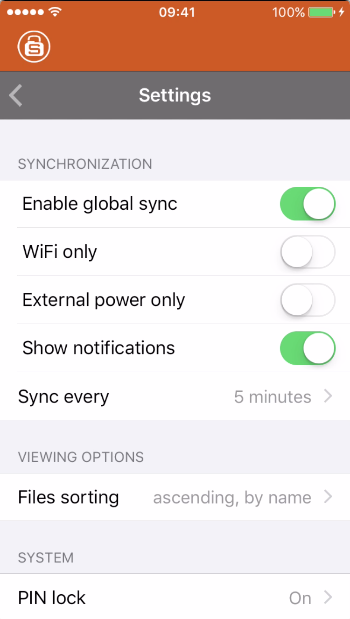
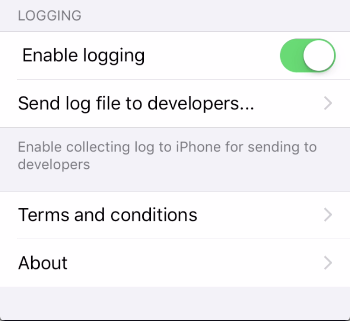
Setting |
Description |
|---|---|
Enable global sync |
Enable or disable synchronisation for all accounts |
WiFi only |
Enable or disable synchronisation when connected using WiFi |
External power only |
Enable or disable synchronisation when connected to a power source |
Show notifications |
Enable or disable notifications |
Sync every |
Set synchronisation interval (5 or 20 minutes, 1 or 3 hour(s) or 1 day |
File sorting |
Sort files on name or modification time either ascending or descending |
PIN lock |
Here you can enable or disable PIN Code lock |
Enable logging |
Enables or disables logging to a file on the iOS device |
Send log file to developers… |
Email log files to Storgrid Support for analysis |
Terms and conditions |
Shows terms and conditions |
About |
Show Version number and copyright information |
Synchronisation¶
On a mobile device not all files are synced locally as on a workstation. But its possible to sync a folder or file to your device, so that you can work off-line. It’s not possible to work off-line if the files are client side encrypted.
You can configure the synchronisation interval in the settings see “Sync every”. When notifications are enabled you will be notified every time the client is syncing. This can also be checked in the notification centre of your iOS device.
You can easily sync a file or folder to your device by pressing the ![]() icon next to file or folder and
icon next to file or folder and ![]() icon.
icon.
You can see if a file or folder is synchronised by this icon:
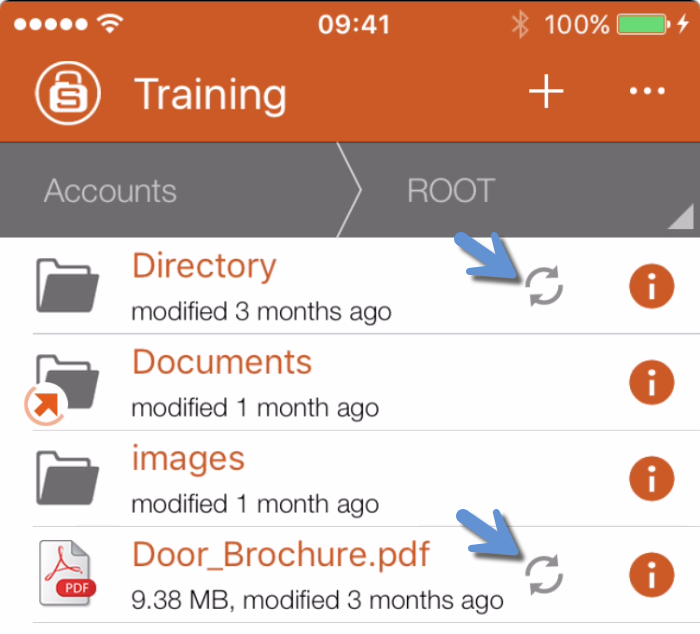
Sharing¶
Sharing is very easy with Storgrid. You can share a file or folder in two ways. From the file navigation view, you can either press the ![]() icon and then touch the
icon and then touch the ![]() button or you can swipe a file or directory to the left and select the
button or you can swipe a file or directory to the left and select the ![]() icon.
icon.
When you share a file with someone the recipient will receive an email of the Storgrid server that a file is shared with him or her.
Additionally it’s also possible to share multiple files/folders, but then it will sent a sharing notification for each file. To share multiple files simply press the ![]() icon and then touch “select”.
icon and then touch “select”.
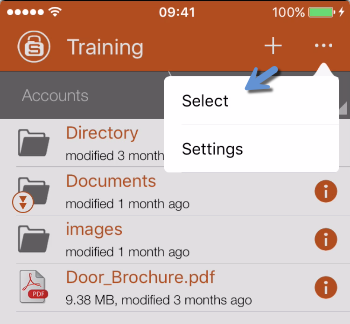
Next you can select the necessary files and/or folders and press share:
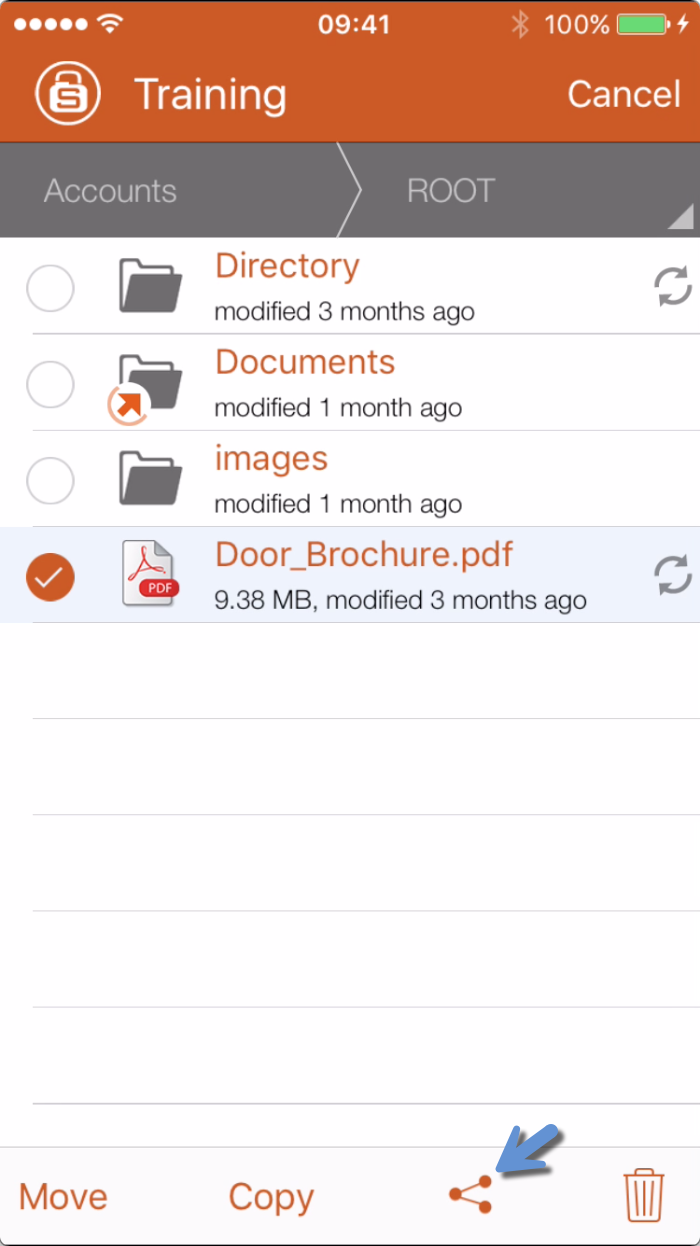
The sharing options will be the same for multiple files and single files. You can share files or directories with two kind of users:
Internal, are users which are registered on the Storgrid server
External, are users of which you only have an email and which are not registered with the Storgrid server yet
Sharing options:
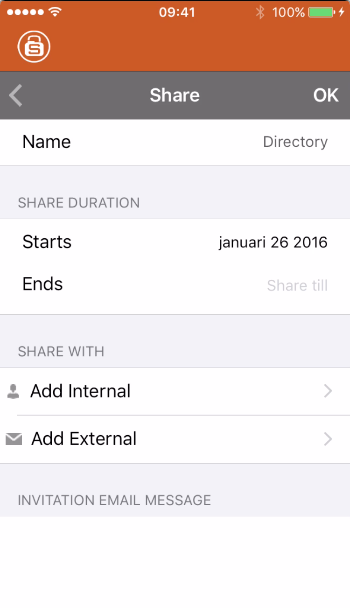
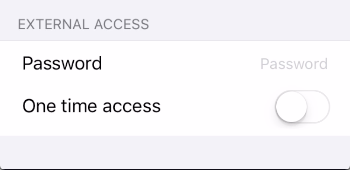
Setting |
Description |
|---|---|
Name |
Name of Share |
Starts |
The date when sharing starts |
Ends |
The date when sharing ends |
Add Internal |
Share with registered internal users |
Add External |
Share with external users, based on emails |
Invitation email message |
A personal sharing message |
Password |
Secure share with a password |
One time access |
If enabled, only allow user to access share on time |
Versioning¶
The Storgrid has an internal repository of all previous deleted and edited files. In other words you can easily revert, if you delete a file by accident.
Touch the ![]() next to a file and then press on “Versions”:
next to a file and then press on “Versions”:
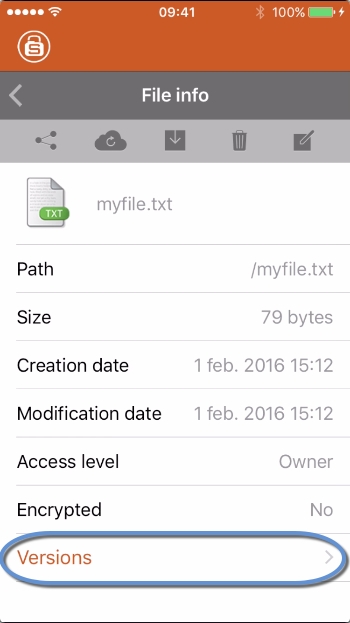
A list of versions will be shown of the file:
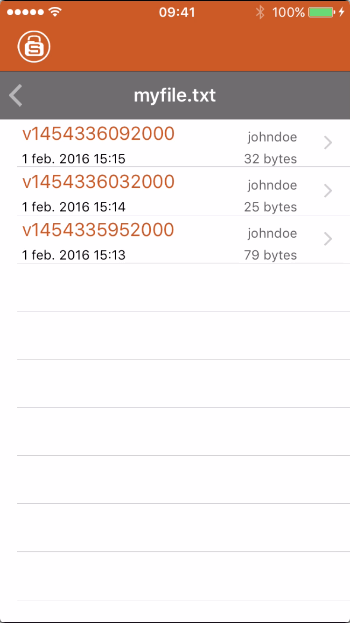
Note
It could be that there are no versions displayed, in this case there are no versions (yet).
When you select a version the following screen will be displayed:
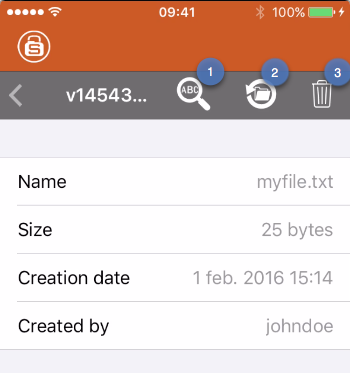
No. |
Description |
|---|---|
1 |
Show version in SmartOffice or Native viewer |
2 |
Revert to selected version |
3 |
Delete File |
Uninstall¶
Please refer to iOS user manual of Apple to remove the Storgrid application from your iOS device.
